
15 Fun Science Projects for Kids
- Fun Learning Games at Home
When it comes to learning science, there can be nothing more fun than science projects for kids.
Sure, you can learn a lot more in a shorter amount of time by
reading through a textbook, but think about your understanding of
science: You remember more of the experiments you did than of the
studying you did (unless you are a chemist or professional
scientist) ;-)
All those
fun science fair projects for kids, kids science projects at
home, the easy science projects you did
at school, and the
science activities for kids that you did when
you were young stuck in your head way better than the kids science
worksheets or tests you had.
If you really want your kids to
learn real science 4 kids, you will find that the kids science
projects and kids science fair projects are the best way to teach
them.
If you can spend some time preparing these science fair
ideas for kids, reading science articles for kids, and doing these
kid science projects, you can make it so much more fun for your kids
to learn about the potentially dull subject that is science.
Exciting Ways to Make Science for Kids Fun
Making science projects for kids fun can be a challenge, especially
if you are a busy parent.
Don't know what to do to make it
fun for your kid?
Here are a few simple ideas that you can
try:
Hit the Museum but Don't Expect to See It all
 There are museums in pretty much every city in the country, and you
will find that taking time to visit some of these museums will be
the way to go to make science fun for your kids.
There are museums in pretty much every city in the country, and you
will find that taking time to visit some of these museums will be
the way to go to make science fun for your kids.
Lower your
ambitions in relation to seeing everything there. Focus on one
section in-depth as your child's attention and focus is probably
going to be short but intense while it lasts.
The good thing
about seeing only a small part of the museum, means that there'll be
a lot more to come back to next time. :-)
A visit to the
museum will be totally worth it to help spark your child's interest
in science.
Do Experiments and Projects ... And Get Your Hands Dirty
Nothing is more fun than science projects where they can
get their hands and clothes dirty with real live experiments - so
have fun testing all kinds of fun science stuff with your kid.
Use the list of fun science projects for kids below to help you
come up with great ideas of fun experiments you can do with your
child.
Get a Science Kit to Play with at Home
Just because your child may not be interested in science now, it
doesn't mean that he or she will never be.
Why not get them
a science kit and use it to do fun experiments? It may be just what
they need to turn them on to the many joys of science.
Making
science fun is important, so do what you can to make it a thrill for
your kids in order to help them to learn.
Making Kids Science Safe - Tips for Preparation and Safety
Science can be dangerous business, so it's important to take a few precautions to be safe while doing science experiments:
-
 Always wear goggles and gloves when doing experiments
involving chemicals as strong as or stronger than vinegar and
baking soda
Always wear goggles and gloves when doing experiments
involving chemicals as strong as or stronger than vinegar and
baking soda - Avoid tasting any kind of chemical, no matter how awesome it
looks to have a tongue that glows in the dark.
- Make sure that your child has his or her hair well out of
the way, and keep it under a hat or tied back.
- Be certain that the experiments are only ever conducted when
you are present.
- Make sure to wash all containers after use, as chemicals can
cause problems if they get in the water or the food.
- Be wary with all kinds of acids, chemicals, solutions, soaps, and substances that may cause harm.
... Avoid the use of these things with small children.
Being
safe with science is actually a lot easier than you might think, but
taking these precautions can help to ensure that you are always as
safe as possible.
15 Fun and Easy Science Projects to Do at Home
If you want to help your child learn all about science, here are
some fun science projects for kids that you can use to teach them
about science at home:
1) Floating Ball
 Using a hair dryer and a ping pong ball, you can teach your kids all
about how hot air makes stuff float.
Using a hair dryer and a ping pong ball, you can teach your kids all
about how hot air makes stuff float.
How does it work?
Step 1: Make sure the hair dryer is plugged in
and turn the power on.
Step 2: Set the hair
dryer on the most powerful setting it has, and point it into the
air.
Step 3: Hold the ping pong ball an inch
or two above the hair dryer.
Step 4: Release
the ball and see it float straight up into the air.
The scientific explanation behind this one science project for
kids:
The reason it works is because the hot air is
being blown at the ball, which is itself filled with air.
The ball will float straight up because the air is creating a wall
of pressure around the ball that pushes it inwards towards the
center of the air stream.
2) Balloon Speakers
 Did you know that you can make a balloon work like a speaker set
that will make sounds louder?
Did you know that you can make a balloon work like a speaker set
that will make sounds louder?
Here is how to do this fun
experiment:
Step 1: Inflate the balloon
using your lungs.
Step 2: Place the balloon
against one of your ears.
Step 3: Use your
finger to tap the side of the balloon opposite to your ear.
The scientific explanation behind this science
project:
You should hear the sound much
louder through the balloon, as the sound is vibrating through the
molecules trapped inside the balloon and forcing them to conduct the
sound.
It will be much louder due to the molecules being
tightly packed together inside the balloon.
3) Secret Spy Ink
 If you want to have fun teaching your kids about acids and their
reaction to certain ingredients, try teaching them how to make
invisible ink using lemon juice:
If you want to have fun teaching your kids about acids and their
reaction to certain ingredients, try teaching them how to make
invisible ink using lemon juice:
Step 1:
Squeeze one fresh lemon into a cup, and add a bit of water to thin
the juice out.
Step 2: Stir the juice well
with the water, and dip a Q-tip into the juice to absorb it into the
cotton.
Step 3: Use the cotton tip to write
on a piece of paper, and dip repeatedly to ensure the message clear.
Step 4: Let the water and juice dry, and notice
how it becomes invisible.
Step 5: Once the
ink has dried, let it sit for a few hours with the invisible message
written on it.
Step 6: After time has
passed, use your stove or a hair dryer to heat up the paper and
watch the ink become visible.
The scientific
explanation:
So how does this experiment work?
Simple: the acid of
the lemon juice turns brown and oxidizes when you heat it up.
By adding the water, you make the ink almost impossible to see
on a piece of white paper, thus it looks as if there is nothing on
the piece of paper until heat is applied.
4) Ice Melting Overflow
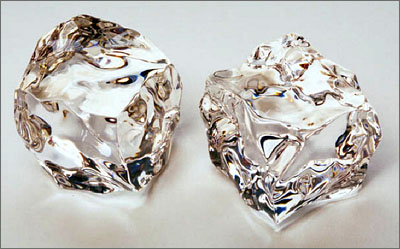 Ice is just water that has turned into a solid, but it also expands.
Ice is just water that has turned into a solid, but it also expands.
Will ice overflow a cup of water once it melts?
Here
is an experiment to test this question:
Step 1:
Fill a cup 3/4 of the way with water.
Step 2:
Add ice until the water level is at the brim.
Step 3:
Set the glass aside and let time pass as the ice melts.
Step 4: Come back hours later to check whether the
water has overflowed or not.
The scientific
explanation:
In fact, the water will not overflow the cup, as the
mass of the water produced by melting the ice is less than the mass
of the ice cube itself.
Ice takes up more space, but water
is denser.
5) Vinegar and Steel
 Rust can be dangerous, and this nifty experiment can be a great way
to teach your kids all about rust and how important it is to be
careful around it:
Rust can be dangerous, and this nifty experiment can be a great way
to teach your kids all about rust and how important it is to be
careful around it:
Step 1: Get a brand new
piece of steel wool from its package, and place it in a metal bowl
or a glass container.
Step 2: Pour vinegar
into the bowl or container, and let the steel wool soak in the
vinegar for a minute or two.
Step 3: Drain
the vinegar, place a thermometer in the steel wool, and place both
in the container covered with an airtight lid.
Step
4: Watch as the temperature inside the container climbs
after just a few minutes.
The quick scientific
explanation behind this one of science experiments for kids:
So how does this work?
The vinegar is an acid that will
cause the steel wool to oxidize (rust), and this oxidation actually
causes a chemical reaction which produces heat.
This heat
increases the temperature inside the container, and is an exothermic
chemical reaction that produces heat that radiates outward.
6) Straw Bending Illusion
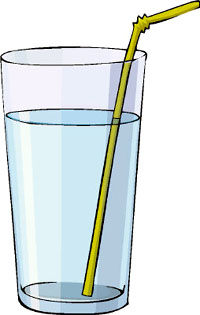 Water has amazing properties, but did you know that water can trick
your eyes and make you see things that aren't' really real?
Water has amazing properties, but did you know that water can trick
your eyes and make you see things that aren't' really real?
Here is a cool experiment to try:
Step 1:
Fill a glass nearly full with water.
Step 2:
Place a straw inside the glass and see how the straw appears to bend
when it makes contact with the surface of the water in the cup.
The quick scientific explanation behind this science project for kids:
Light travels through air
one way, but it travels through water a completely different way.
When we see light through water, it looks totally different than it
does when we see light in the atmosphere.
Air barely
refracts light, while water is much more refractive and thus the
straw appears to be bent.
7) Water Creatures
 Did you know that there are tiny creatures all around us, in the
ground, the air, and the water? You can teach your kids about the
tiny creatures by doing this experiment:
Did you know that there are tiny creatures all around us, in the
ground, the air, and the water? You can teach your kids about the
tiny creatures by doing this experiment:
Step 1:
Set up a microscope, and set it on the highest setting to ensure
that you can see things as small as possible.
Step 2:
Get some water from different sources (the pond, the water fountain,
the drinking water, the tap water, the sink, the shower, etc.), and
put a drop of each kind of water on a slide.
Step 3:
Set each slide under the microscope in turn, and see what kind of
creatures are in each kind of water, how they move, and what they
look like.
You might be surprised to find that there are
creatures in water that you thought was perfectly clean, but don't
worry.
Not all water creatures are harmful, but you can
identify which creatures will do you harm and which are beneficial.
8) Water Music
Did you know that you can make music with water?
Try this
fun and simple experiment and see how many tunes you can play:
Step 1: Fill glass cups or bottles with
different amounts of water.
Step 2: Use a
pencil or a wooden stick to hit each one in turn, and hear how each
glass sounds different.
The scientific explanation
behind this science project:
The
reason that the glasses sound different is that the vibrations of
each glass will cause sounds waves to travel through the water in
the glass.
The glasses with the most water will have very
low sounds due to the water dampening the waves, while the glasses
with the least water will have higher sounds thanks to the lack of
water dampening the sound.
9) Potato Stabbing
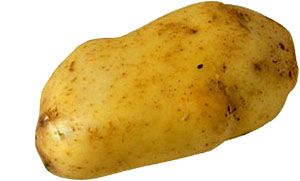 It is amazing what pressure can do, and you can actually stab a
straw into a potato by using air pressure.
It is amazing what pressure can do, and you can actually stab a
straw into a potato by using air pressure.
Want to know how
it works?
Step 1: Hold your thumb over the
end of a straw, and stab the other end into a potato.
Step 2: Remove your thumb from the end of the straw,
and stab it into the potato again.
The scientific
explanation:
So what happens?
When you cover the end of the
straw, the air inside the straw is trapped and compressed, which
stiffens the walls of the straw and makes it powerful enough to stab
into a potato. Without the air pressure, the straw will bend and
flex too easily.
10) Spinning Water
Centrifugal force is a powerful one, and it is important that your
children understand it so they know how it affects them in many
areas of their life.
Here is a neat trick to teach them all
about it:
Step 1: Get a bucket that has a
strong handle, and fill it ¼ with water.
Step 2:
Make sure all of your kids are standing back, and spin around
quickly with the bucket of water.
Step 3:
Start off spinning slowly, keeping the bucket near the ground. Work
up the speed of the spinning bucket, and start spinning it up high,
over your head, etc.
The quick scientific explanation
behind this science project:
The
force of gravity is pulling the water towards the edges of the
bucket, and the water will stay that way until you stop spinning.
Your children will be amazed as you spin the bucket over your head
and none of the water falls out – thanks to centrifugal force.
11) Salt Crystals
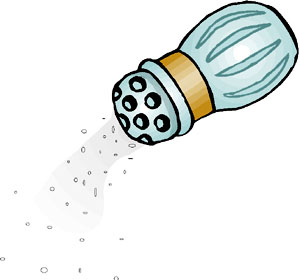 Teaching your children about crystals can be lots of fun, especially
if you use the experiment below to teach them about salt crystals:
Teaching your children about crystals can be lots of fun, especially
if you use the experiment below to teach them about salt crystals:
Step 1: Boil a saucepan with drinking water,
making sure the water is properly boiling.
Step 2:
Add a lot of salt to the water, and be certain that all of the salt
crystals have been properly dissolved into the water.
Step 3: Pour the salt water into a glass jar. Cut a
piece of thread roughly long enough to go around the largest three
fingers of your hand once.
Step 4: Tie one
end of the thread to a pencil roughly 2/3 of the way from the end,
and tie the other end two inches away.
Step 5:
Place the pencil on top of the jar, allowing the thread to dangle in
the salt water.
Step 6: Let the jar of
water sit for a few hours to a few days.
The
scientific explanation behind this one of science activities for
kids:
As the salt in the water cools down, it will
harden. Some of the salt crystals will stick to the thread, and you
will be able to pull out the thread and see the long string of
shining crystals that your child has made.
12) Rainbow Creator
Making your own rainbow is actually quite easy, though it won't be
on the same scale as the rainbows you see stretched across the sky
on a rainy day.
Step 1: Fill a glass with
drinking water to 3/4.
Step 2: Grab a piece
of white paper and bring it and the glass of water to the nearest
window where the sun is shining through.
Step 3:
Hold the glass of water up to the sun light, and place the piece of
paper behind it.
The quick scientific explanation:
When
you hold the glass of water up to the light, the rays of the sun
pass through it and refract (separate).
The white piece of paper behind the glass will show you how the
colors separate as the light passes through the glass, and thus you
will be able to see your rainbow.
13) Rising Air
This is a neat trick that you can use to teach your kids about hot
air, how it rises, and how it is used to make hot air balloons float.
Step 1: Get a regular balloon and an empty
plastic soda bottle.
Step 2: Put a pot of
water on the stove to boil.
Step 3: Stretch
the mouth of the balloon over the mouth of the soda bottle, but
don't inflate the balloon.
Step 4: Place the
bottle in the hot water, and use a pair of tongs to hold the bottle
there.
Step 5: When the water heats up the
air inside the empty soda bottle, the hot air will rise, and the
balloon will expand with the air from the bottle.
You can use
this experiment to teach your kids about how hot air rises, which is
why the second floor of your home is always hotter than the first
floor.
You can also explain how the hot air balloons fill
with the air that causes them to drift upwards.
14) Water and Electricity
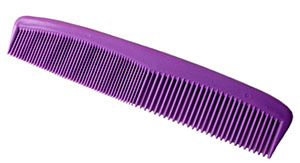 This is a cool experiment that you can do to show your kids how
static electricity can cause water to bend:
This is a cool experiment that you can do to show your kids how
static electricity can cause water to bend:
Step 1:
Go to the kitchen sink and turn the water on to a thin trickle (no
more than 1/3 inch across).
Step 2: Get a
plastic comb and run it through your hair 15 times (just like you
would when brushing your hair) or rub it on a sweater for 15 seconds.
Step 3: Place the teeth of the comb near the
stream of water.
The quick scientific explanation:
The
static electricity in the comb will pull the water molecules towards
it, and it will make the stream of water appear as if it were
bending.
15) Science Projects for Kids: Toy Parachute
The project below is an interesting one that can help you to teach
your children about wind resistance and how drag is created when the
wind pulls on large objects:
Step 1: Use a
pair of scissors to trim the edges from a plastic shopping bag and
make a large square.
Step 2: Tape four
strings 4 inches long to the four corners of your square.
Step 3: Stand on a chair and drop a plastic toy
to the floor. Have your children record how long it takes to fall.
Step 4: Tape the four strings onto the plastic
toy, and drop it from the chair. Have your kids count how long it
takes to fall.
Step 5: Repeat the same
experiment from a high place, such as from a window.
The quick scientific explanation behind this one of science
experiments for kids:
When the parachute spreads
out, it creates resistance that prevents it from falling too fast,
which is why parachutes are used to slow falling people.
Your
Positive Parenting Ally,
Birgitte

Want to stay in touch and get the latest news?
Sign up
for my free newsletter
Parent Coaching
- For Inner Peace, Clarity and a Deeper Connection to Your Child
 Being a parent can feel like a double-edged sword. Life with kids may feel like the greatest gift you have ever received, while at the same being hugely challenging, often leaving you confused, stressed and overwhelmed.
Being a parent can feel like a double-edged sword. Life with kids may feel like the greatest gift you have ever received, while at the same being hugely challenging, often leaving you confused, stressed and overwhelmed.
When we feel like this, we've lost touch with ourselves. We can't hear our own inner voice, and it's difficult to know what is 'right' for us and how to act.
I offer in-depth parent coaching to help you regain your balance and get back in touch with yourself. From a place of inner peace and clarity, your will find your own answers which will help you reconnect with your child from a place of unconditional love and acceptance.
Read more about my parent coaching here.
Where Would You Like to Go Next?
Fun Science Games and Experiments for Kids
 27 Learning Games for Kids A List of the Best Educational Games for Kids. |
 14 Fun Science Experiments for Kids: Guidelines for Kids Science Projects and Learning Games. |
 14 Science Fair Projects for Kids: Easy Guidelines to Fun Science Fair Ideas. |
 12 Fun Experiments for Kids: Easy Science Projects for Kids to Do at Home or in School. |
 36 Recommended Science Websites for Kids: Science Sites for Kids That Make Learning Fun. |
 Fun Facts about the Solar System for Kids and Fun Kids Astronomy Games. |
Fun Math Games for Kids
 Fun Multiplication Math Games and Educational Times Tables Activities for Kids. |
 Exciting Math for Kids 16 Fun Math Activities and Counting Games. |
 Educational Kids Math Games Cool Math Websites and Physical Fun Math Activities. |
 22 Cool Math Games for Kids Fun Math Activities with Multiplication, Addition and Subtraction. |
 15 Fun Math Games for Kids: Turning Multiplication, Addition and Fraction into Fun Math Activities. |
 Cool Math Games for Kids and Fun Math Activities for All Ages. |
Back to the top of this page about 15 Fun Science Projects for Kids - Fun Learning Games at Home
Go to the Positive Parenting Ally Homepage







